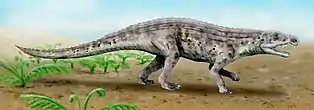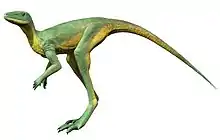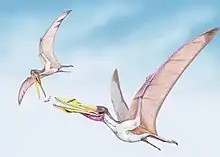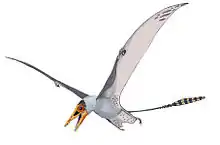| |||
|---|---|---|---|
| +... |
Paleontology or palaeontology is the study of prehistoric life forms on Earth through the examination of plant and animal fossils.[1] This includes the study of body fossils, tracks (ichnites), burrows, cast-off parts, fossilised feces (coprolites), palynomorphs and chemical residues. Because humans have encountered fossils for millennia, paleontology has a long history both before and after becoming formalized as a science. This article records significant discoveries and events related to paleontology that occurred or were published in the year 1971.
Arthropods
Crustaceans
| Name | Novelty | Status | Authors | Age | Type locality | Location | Notes | Images |
|---|---|---|---|---|---|---|---|---|
|
Sp nov |
jr synonym |
Via |
Moved to the genus Delclosia |
|||||
|
Pseudastacus llopisi[2] |
Sp nov |
jr synonym |
Via |
A crayfish, moved to the genus Austropotamobius in 1997.[3] |
||||
Plants
Angiosperms
| Name | Novelty | Status | Authors | Age | Type locality | Location | Notes | Images |
|---|---|---|---|---|---|---|---|---|
|
Sp nov |
jr synonym |
Mathewes & Brooke |
A mallow relative. |
| ||||
Conodonts
| Name | Novelty | Status | Authors | Age | Type locality | Country/subdivision | Notes | Image |
|---|---|---|---|---|---|---|---|---|
|
gen nov |
valid |
|||||||
|
gen nov |
valid |
|||||||
|
gen nov |
valid |
Archosauromorphs
Newly named pseudosuchians
| Name | Novelty | Status | Authors | Age | Type locality | Country/subdivision | Notes | Image |
|---|---|---|---|---|---|---|---|---|
|
gen et sp nov |
valid |
|
Newly named dinosaurs
Data courtesy of George Olshevsky's dinosaur genera list.[7]
| Name | Novelty | Status | Authors | Age | Type locality | Country/subdivision | Notes | Image |
|---|---|---|---|---|---|---|---|---|
|
gen et sp nov |
Valid |
Nowinski |
||||||
|
gen et sp nov |
Valid |
|||||||
Newly named onithodirans
| Name | Novelty | Status | Authors | Age | Type locality | Country/subdivision | Notes | Image |
|---|---|---|---|---|---|---|---|---|
|
gen et sp nov |
Valid |
A member of the lagerpetonidae. |
| |||||
|
fam et gen et sp nov |
valid |
|||||||
Newly named birds
| Name | Novelty | Status | Authors | Age | Type locality | Country/subdivision | Notes | Image |
|---|---|---|---|---|---|---|---|---|
|
Anser devjatkini[11] |
Sp. nov. |
Valid |
Hyargas Nuur Formation |
An Anatidae. |
||||
|
Gen. et sp. nov. |
jr synonym |
Late Quaternary |
Las Breas de San Felipe |
An accipitrid, |
||||
|
Bathornis minor[14] |
Sp. nov. |
Valid |
||||||
|
Sp. nov. |
Valid |
Brunet |
A bucorvid. |
|||||
|
Campephilus dalquesti[16] |
Sp. nov. |
Valid |
A picid. |
|||||
|
Cerorhinca minor[17] |
Sp. nov. |
Valid |
An alcid. |
|||||
|
Cygnus pristinus[11] |
Sp. nov. |
Valid |
Chirgiz-Nur Formation |
An anatid. |
||||
|
Dolichonyx kruegeri[18] |
Sp. nov. |
Valid |
Fischer & Stephan |
"Cave deposits" |
An icterid. |
|||
|
Gen. et sp. nov. |
Valid |
A bathornithid. Type species E. uintae |
||||||
|
Fulica picapicensis[18] |
Sp. nov. |
jr synonym |
Fischer & Stephan |
"Cave deposits" |
A flightless rallid, |
|||
|
Sp. nov. |
Valid |
Fischer & Stephan |
"Cave deposits" |
A crane. |
 Antigone cubensis (top) | |||
|
Macrorhamphus finitimus[11] |
Sp. nov. |
Valid |
A scolopacid, |
|||||
|
Sp. nov. |
Valid |
A mancaline alcid |
||||||
|
Onychopteryx[21] |
Gen. et sp. nov. |
Valid |
Casamajor Formation |
An onychopterygid |
||||
|
Phalacrocorax mongoliensis[11] |
Sp. nov. |
Valid |
||||||
|
Sp. nov. |
Valid |
Early or Middle Oligocene (Duntroonian) |
A spheniscid. |
|||||
|
Progrus[23] |
Gen. et sp. nov. |
Valid |
Bendukidze |
Kalmakpai River |
An eogruid. |
|||
|
Proplegadis[24] |
Gen. et sp. nov. |
Valid |
Harrison & Walker |
A possible phaethontid, |
||||
|
Puffinus tedfordi[17] |
Sp. nov. |
Valid |
A procellariid. |
|||||
|
Sp. nov. |
jr synonym |
A spheniscid, |
||||||
|
Spizaetus tanneri[27] |
Sp. nov. |
Valid |
Martin |
Broadwater Formation |
An accipitrid. |
|||
|
Struthio transcaucasicus[28] |
Sp. nov. |
Valid |
Burchak-Abramovich & Vekua |
Late Pliocene (Akchagil age) |
A struthionid. |
|||
|
Wimanornis[29] |
Gen. et sp. nov. |
Valid |
A basal spheniscid |
|||||
Newly named pterosaurs
| Name | Novelty | Status | Authors | Age | Type locality | Country/subdivision | Notes | Image |
|---|---|---|---|---|---|---|---|---|
|
gen et sp nov |
Valid |
Price |
| |||||
|
gen et sp nov |
Valid |
possible rhamphorhynchid |
| |||||
Other Animals
| Name | Status | Authors | Age | Unit | Location | Notes | Images |
|---|---|---|---|---|---|---|---|
| Chondroplon | Valid | Wade | Ediacaran | Sometimes considered a synonym of Dickinsonia | |||
References
- ↑ Gini-Newman, Garfield; Graham, Elizabeth (2001). Echoes from the past: world history to the 16th century. Toronto: McGraw-Hill Ryerson Ltd. ISBN 9780070887398. OCLC 46769716.
- 1 2 Via, Luis (1971). "Crustáceos decápodos del Jurásico Superior de Montsech (Lérida)". Cuadernas Geología Ibérica. 2: 607–612.
- ↑ Garassino, Alessandro (1997). "The macruran decapod crustaceans of the Lower Cretaceous (Lower Barremian) of Las Hoyas (Cuenca, Spain)". Atti della Società Italiana di Scienze Naturali e del Museo Civico di Storia Naturale in Milano. 137 (1–2): 101–126.
- ↑ Manchester, S.R. (1992). "Flowers, fruits and pollen of Florissantia, an extinct malvalean genus from the Eocene and Oligocene of western North America". American Journal of Botany. 79 (9): 996–1008. doi:10.2307/2444909. JSTOR 2444909.
- 1 2 3 Lindström Maurits (1971). "Vom Anfang, Hochstand und Ende eines Epikontinentalmeeres". Geologische Rundschau. 60 (2): 419–438. Bibcode:1971GeoRu..60..419L. doi:10.1007/BF02000464. S2CID 128476116.
- ↑ Bonaparte, J.F. 1970. Annotated list of the South American Triassic tetrapods. Second Gondwana Symposium South Africa, Proceedings and Papers: pp. 665-682.
- ↑ Olshevsky, George. "Dinogeorge's Dinosaur Genera List". Archived from the original on 2011-07-15. Retrieved 2008-08-07.
- ↑ Nowinski, A. 1971. Nemegtosaurus mongoliensis n. gen., n. sp (Sauropoda) from the uppermost Cretaceous of Mongolia. Palaeontol. Polonica 25: pp. 57-81.
- ↑ Galton, P.M. 1971. A primitive dome-headed dinosaur (Ornithischia: Pachycephalosauridae) from the Lower Cretaceous of England, and the function of the dome in pachycephalosaurids. J. Paleontol. 45: pp. 40-47.
- 1 2 Romer, A.S. 1971. The Chañares (Argentina) Triassic reptile fauna. X. Two new but incompletely known long-limbed pseudosuchians. Breviora 378: pp. 1-10.
- 1 2 3 4 Evgeny N. Kurochkin (1971). "[On the Pliocene Avifauna of Mongolia]". Transactions of the Joint Soviet-Mongolian Geological Expedition. 3 (5): 58–69.
- ↑ Oscar Arredondo (1971). "Nuevo Género y Especie de Ave Fósil (Accipitriformes: Vulturidae) del Pleistoceno de Cuba". Memoria de la Sociedad de Ciencias Naturales la Salle. 31 (90): 309–323.
- ↑ Suárez, W.; Emslie, S.D. (2003). "New fossil material with a redescription of the extinct condor Gymnogyps varonai (Arredondo, 1971) from the Quaternary of Cuba (Aves: Vulturidae)" (PDF). Proceedings of the Biological Society of Washington. 116 (1): 29–37.
- 1 2 Joel Cracraft (1971). "Systematics and Evolution of the Gruiformes (Class, Aves) 2. Additional Comments on the Bathornithidae, with Descriptions of a New Species" (PDF). American Museum Novitates (2449): 1–14.
- ↑ J. Brunet (1971). "Oiseaux Miocénes de Beni Mellal (Maroc), un Complément à Leur Étude". Notes et Mémoires, Service Géologique (Morocco). 31: 109–111.
- ↑ Pierce Brodkorb (1971). "The Paleospecies of Woodpeckers" (PDF). Quarterly Journal of the Florida Academy of Sciences. 33: 132–136. Archived from the original (PDF) on 2014-10-30. Retrieved 2014-10-29.
- 1 2 3 Hildegarde Howard (1971). "Pliocene Avian Remains from Baja California" (PDF). Museum of Natural History of Los Angeles County, Contributions in Science. 217: 1–17. Archived from the original (PDF) on 2014-10-28. Retrieved 2014-10-28.
- 1 2 Karlheinz Fischer; Burkhard Stephan (1971). "Weitere Vogelreste aus dem Pleistozän der Pio-Domingo-Höhle in Kuba". Wissenschaftliche Zeitschrift der Humboldt-Universität zu Berlin. Mathematisch-naturwissenschaftliche Reihe. 20: 593–607.
- ↑ Karlheinz Fischer; Burkhard Stephan (1971). "Ein Flugunfahiger Kranich (Grus cubensis n.sp.) aus dem Pleitozän von Kuba - eine Osteologie der Familie der Kraniche (Gruidae)". Wissenschaftliche Zeitschrift der Humboldt-Universität zu Berlin. Mathematisch-naturwissenschaftliche Reihe. 20: 541–592.
- ↑ William Suárez (2020). "The fossil avifauna of the tar seeps Las Breas de San Felipe, Matanzas, Cuba". Zootaxa. 4780 (1): zootaxa.4780.1.1. doi:10.11646/zootaxa.4780.1.1. PMID 33055754. S2CID 219510089.
- ↑ Joel Cracraft (1971). "A New Family of Hoatzin-like Birds (Order Opisthocomiformes) from the Eocene of South America" (PDF). Ibis. 113 (2): 229–233. doi:10.1111/j.1474-919x.1971.tb05148.x.
- ↑ George G. Simpson (1971). "A Review of the Pre-Pliocene Penguins of New Zealand" (PDF). Bulletin of the American Museum of Natural History. 144 (5): 319–378.
- ↑ Oleg G. Bendukidze (1971). "Novyj prestavitel' semeistva Geranoididae (Aves, Gruiformes) iz eotsenovykh otlozhenij Zaisan". Soobtzhenija Akademii Nauk Gruzinskoj SSSR. 63: 749–751.
- ↑ Colin J. O. Harrison & Cyril A. Walker (1971). "A New Ibis from the lower Eocene of Britain". Ibis. 113 (3): 367–368. doi:10.1111/j.1474-919x.1971.tb05169.x.
- ↑ George G. Simpson (1971). "Fossil Penguin from the Late Cenozoic of South Africa". Science. 171 (3976): 1144–1145. Bibcode:1971Sci...171.1144G. doi:10.1126/science.171.3976.1144. PMID 17777603. S2CID 35775139.
- ↑ George G. Simpson (1975). "Notes on Variation in Penguins and on Fossil Penguins from the Pliocene of Langebaanweg, Cape Province, South Africa". Annals of the South African Museum. 69 (4): 59–72.
- ↑ Larry D. Martin (1971). "An Early Pleistocene Eagle from Nebraska" (PDF). Condor. 73 (2): 248–250. doi:10.2307/1365848. JSTOR 1365848.
- ↑ Nikolay I. Burchak-Abramovich & Abesalom K. Vekua (1971). "The Fossil Ostrich from the Akchagil Layers of Georgia". Acta Zoologica Cracoviensia. 16 (1): 1–28.
- ↑ George G. Simpson (1971). "Review of the fossil penguins from Seymour Island". Proceedings of the Royal Society of London B. 178 (1053): 357–387. Bibcode:1971RSPSB.178..357S. doi:10.1098/rspb.1971.0070. S2CID 84900109.




